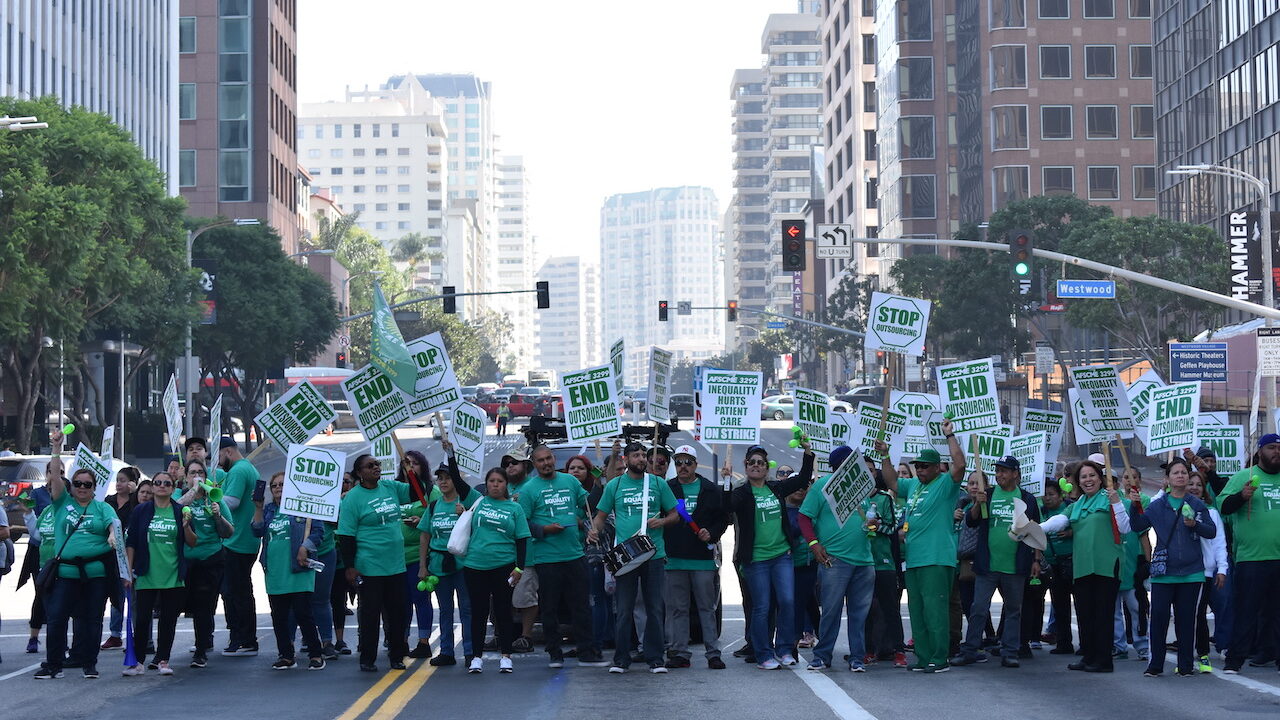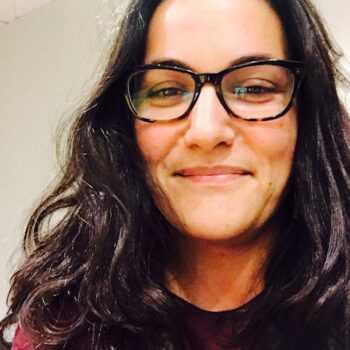This past June, several faculty and grad student unions asked my union, AFSCME 3299, to sign on to a letter demanding remote-only instruction in the fall. If students come back to campus, the letter rightly stated, COVID-19 will spread, and people will die.
As much as I feared the spread of COVID on UC campuses, AFSCME 3299 couldn’t sign on to a letter demanding campus closures, even knowing the risks that our members faced. Our union represents the 27,000 cooks, custodians, gardeners, bus drivers, and hospital technicians who work at the University of California, the state’s third-largest employer. They are the lowest paid-workers in the university system. Many of them harbor memories of the 2008 recession, when austerity cuts and job outsourcing widened an already untenable income gap.
Now, as a new recession takes root, their jobs depend on students living and learning on campus. These mostly Black and brown workers have had to make an impossible choice: between starvation and eviction or exposure to COVID-19.
How did the nation’s premier public university system create such a brutal dilemma for its lowest paid workers? The answer is what many in higher ed have bemoaned for years: higher ed is a lucrative business for some and an increasingly bad deal for the rest of us.
COVID-19 and the Racialized Inequities of Higher Education
COVID-19 has laid bare the racial inequities in opportunity, income, and career advancement at the University of California and across higher education. As the virus threatens universities’ revenue sources — tuition payments, room and board, hospital procedures, sports games — administrators are instituting harsh austerity measures that disproportionately affect Black and brown workers and students. The lowest paid workers are being hit with layoffs and furloughs. Adjunct faculty, more likely to be women and people of color, aren’t being rehired.
The University of California wants to pretend the current crisis is out of its control. But this latest round of austerity measures stems from a broken and increasingly privatized business model. After decades of state budget cuts, public higher education is now more beholden to the whims of the market than its core public mission.
Most major public university administrations and boards are stacked with Wall Street insiders — a trend that opens the door to potential conflicts of interest. Take, for example, UC Board of Regents member Richard Blum, the husband of Senator Diane Feinstein and a billionaire investor. Blum recently used his status as a donor and Regent to help get his friends’ unqualified children into UC Berkeley, at the exclusion of more qualified students. Blum was a also key member of the board when UC began investing billions of university endowment dollars in hedge funds and private equity firms with stakes in the housing market, private prisons, and fossil fuels — often paying out huge expenses to fund managers for investments that delivered relatively meager returns
As Chair of the Board in the 2000s, Blum also spearheaded UC’s efforts to become a private development haven, borrowing billions to grow its medical centers and campuses while leaving the university incredibly debt-burdened. Under this model, the university relied on “public-private partnerships” to build new student dormitories. Now, UC is required to pay on these loans in full, even though the dorms are mostly empty — spurring the layoffs of dozens of dorm custodians.
University campuses themselves drive gentrification, over-policing, and rising housing costs in the surrounding communities, which are often majority Black and brown. Then, instead of offering the residents of these communities living wage jobs with benefits, universities outsource the work to poverty-wage, non-union contractors — weakening the collective voice of workers on the job.
Reimagining Higher Ed
It is time to re-imagine higher education to end the racialized inequities of the current paradigm and create more educational opportunities for all.
We need a national system of publicly-funded, quality, accessible, and accountable higher education institutions whose missions center low-income Black and brown students, workers, and faculty. Public funding should ensure a seat at the table for the students and workers currently shut out of most decision-making processes at universities. Public funding should also guarantee collective bargaining rights, community benefits for surrounding communities in any university development, direct financial support for Black, brown, and historically disadvantaged students (including room, board, and living assistance), and an end to the corporate system of governance.
Many campaigns have imagined such a publicly-funded, accountable higher education system. Winning it will require a massive movement of students, faculty, workers, and community members. In the labor movement, this means we must flip our orientation away from short-term gains — such as winning raises or fending off benefit cuts — and put publicly-funded, publicly-accountable higher ed at the center of our demands.
Here are a few thoughts on some of the key elements necessary to win such a system:
● Transformational coalitions of higher ed unions, students, and community groups — locally, regionally, and nationally. These coalitions must be marriages, not just speed dating. Transactional relationships are what most organizations have now — and clearly this isn’t enough. Well-resourced labor organizations need to invest resources into student and community-led organizing. These coalitions cannot afford to be siloed. They must share and integrate their resources — like research and public relations capabilities to drive the kind of narrative that can transform public opinion and win lasting political support.
● Demands centering racial equity. Unions, students, and community groups need joint common good demands, like public funding, free room and board for low-income Black and brown students, cops off campus, and reduced administrative bloat. These demands must be part of a long-term transformational agenda — linked to achievable benchmarks — and not just slogans for a one-off campaign whose actual bottom line is a two percent raise or a little bit more funding from the state.
● Deep organizing and listening to our base. We must be brave enough to ask our members what they care about beyond bread-and-butter issues. What’s the campus climate like for the Black and brown staff who cook and clean? Do campus policing and gentrification affect their well being, or is it enough to get them a raise? This kind of organizing takes time and money, but it is worth the investment to build the power and voice of our base.
● Research the wolves in the hen house. We must invest resources in exposing where tuition, room-and-board dollars, state funding, and corporate donations are actually going. How much do university executives get paid? Where is money being hidden? Where is it being invested? And who decides? Exposing the university’s financial decision-making processes won’t get us all the way, but it will help agitate the public and our members.
● The bargaining table as a site of struggle. Worker bargaining is a site of massive power when done right. Unions must align contract negotiation calendars to promote maximum visibility and student involvement. The midterms in 2022 and the next presidential election in 2024 are key opportunities to exert our collective power on whoever is in office. We can start by looking at the Bargaining For Common Good sectoral bargaining map and then work to build our own map for higher ed.
The good news is, there are already some labor organizations — both inside and outside of the higher ed community — undertaking this important work. At Rutgers University, for example, the faculty and graduate student union has long been in deep coalition with other unions as well as student and community groups. The coalition’s demands center racial equity by calling for the least cuts to the lowest paid Black and brown workers and students.
At the University of California, we’ve laid a foundation for this work, but we are still perfecting our model. Our coalition represents a wide range of interests — custodians, adjunct faculty, clerical workers, researchers, tenured faculty, and nurses — but, for decades, we have found common ground around defensive benefit cutback fights. In 2015, a coalition of community groups and AFSCME 3299 fought UC Berkeley’s plan to expand in Richmond – one of the most impoverished black communities in CA – without a community benefits agreement for housing, jobs, and education.
The pandemic has given us an new opportunity to coordinate our fights for adequate Personal Protective Equipment (PPE) and against lay-offs. Together, we identified over $10 billion in reserves that the university could use to keep workers on the payroll while keeping everyone safe. We successfully lobbied to direct savings from debt restructuring to fund low-income students and prevent furloughs and layoffs. Now, UC unions and student groups are also forming a Cops Off Campus campaign to redirect the bloated budget for university police to real community safety measures like additional mental health workers and rape crisis centers
Organizing for a Common Good Agenda
These are all good starts, but more must happen. We have an historic opportunity this coming year: more than a dozen higher education unions contracts come up in 2021. If a dozen campus coalitions started organizing around a common good agenda, it would put thousands in the streets to demand free education for those who need it.
This type of movement isn’t unprecedented.
Starting in the 1930s, construction unions helped create a system of apprenticeship programs that united workers and employers in the single largest privately-financed system of education in America — giving students a middle-class career ladder and a free education where they “earn while they learn,” while providing the construction industry a stable supply of skilled workers.
More recently, the Fight for $15 has brought together a broad coalition of workers, faith-based groups, and allies to set industry standards for thousands of fast food and retail workers, fundamentally changing the conversation about economic inequality and what all workers deserve. Unionized nurses and their progressive allies have made universal healthcare a real political possibility. The education justice movement — from Chicago to West Virginia to Los Angeles — has also made common good demands for equitable funding for public education.
The question for all of us in higher education is whether we too can use our collective power to demand a more just, accessible, and inclusive university. I’m ready to make it happen. Are you?

